check engine JEEP CJ 1953 Service Manual
[x] Cancel search | Manufacturer: JEEP, Model Year: 1953, Model line: CJ, Model: JEEP CJ 1953Pages: 376, PDF Size: 19.96 MB
Page 7 of 376
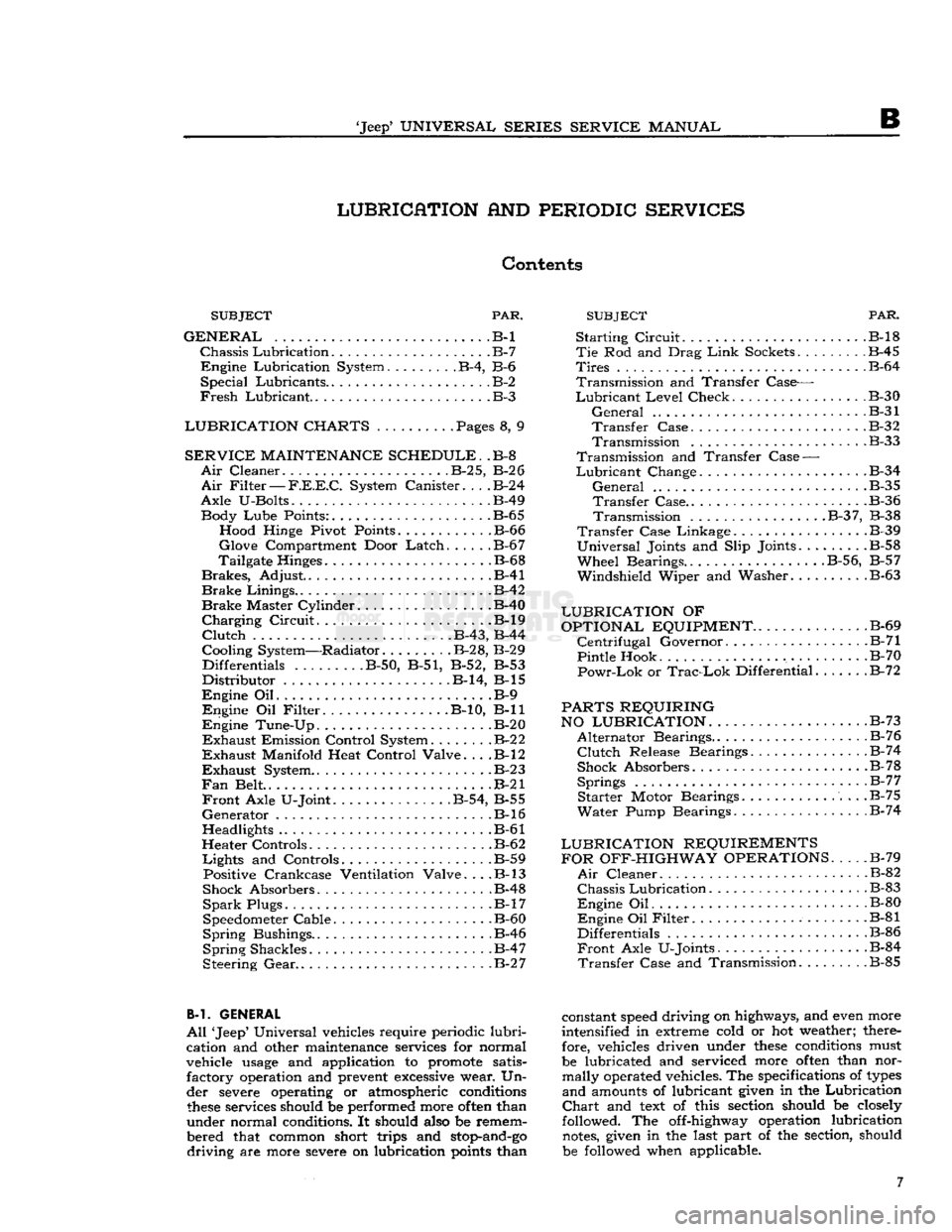
'Jeep*
UNIVERSAL SERIES
SERVICE
MANUAL
B
LUBRICATION
AND
PERIODIC SERVICES
Contents
PAR. SUBJECT
PAR.
SUBJECT
GENERAL
.B-l
Chassis
Lubrication
B-7
Engine
Lubrication System B-4, B-6
Special
Lubricants B-2
Fresh
Lubricant.
.B-3
LUBRICATION CHARTS
. Pages 8, 9
SERVICE
MAINTENANCE SCHEDULE.
.B-8
Air
Cleaner
B-2
5,
B-2
6
Air
Filter
—
F.E.E.C.
System Canister
B-2
4
Axle
U-Bolts B-49 Body
Lube
Points: B-65 Hood Hinge Pivot Points B-66
Glove
Compartment Door
Latch
B-6
7
Tailgate Hinges .B-68
Brakes,
Adjust .B-41
Brake
Linings .B-42
Brake
Master Cylinder B-40
Charging
Circuit
B-l9
Clutch
. B-43, B-44
Cooling System—Radiator. B-28, B-29 Differentials
........
.B-50, B-51, B-52, B-53
Distributor
B-14, B-l5
Engine
Oil B-9
Engine
Oil
Filter
B-10, B-ll
Engine
Tune-Up B-20
Exhaust
Emission Control System
B-2
2
Exhaust
Manifold Heat Control Valve. . . .B-l2
Exhaust
System
B-2 3
Fan
Belt . .B-21
Front
Axle U-Joint B-54, B-55
Generator
.B-16
Headlights B-61
Heater Controls B-62
Lights
and Controls B-59 Positive Crankcase Ventilation Valve. . . .B-l3
Shock Absorbers B-48
Spark
Plugs. B-17
Speedometer Cable. .B-60
Spring
Bushings.. . .B-46
Spring
Shackles .B-47
Steering
Gear
B-2 7
B-l. GENERAL
All
'Jeep' Universal vehicles require periodic
lubri
cation and other maintenance services for normal
vehicle
usage
and application to promote satis factory operation and prevent
excessive
wear. Un
der severe operating or atmospheric conditions
these
services should be performed more
often
than
under normal conditions. It should also be remem
bered that common short trips and
stop-and-go
driving
are more severe on lubrication
points
than
Starting
Circuit
B-l8
Tie
Rod and Drag
Link
Sockets
.
B-45
Tires
B-64
Transmission
and Transfer Case—
Lubricant
Level
Check B-30
General
B-31
Transfer
Case B-32
Transmission
.B-33
Transmission
and Transfer
Case
—
Lubricant
Change .B-34
General
.B-35
Transfer
Case B-36
Transmission
B-3
7, B-38
Transfer
Case Linkage B-39
Universal
Joints and Slip Joints.
.......
.B-58
Wheel
Bearings..
.........
. . .B-56, B-57
Windshield
Wiper and Washer B-63
LUBRICATION
OF
OPTIONAL EQUIPMENT
B-69
Centrifugal
Governor. .B-71
Pintle Hook .B-70
Powr-Lok
or
Trac-Lok
Differential B-72
PARTS REQUIRING
NO LUBRICATION.
. . .B-73
Alternator
Bearings. B-76
Clutch
Release Bearings.
.............
.B-74
Shock Absorbers B-78
Springs
B-7
7
Starter
Motor Bearings B-75
Water
Pump Bearings B-74
LUBRICATION REQUIREMENTS FOR OFF-HIGHWAY OPERATIONS
B-79
Air
Cleaner B-82
Chassis
Lubrication
B-83
Engine
Oil B-80
Engine
Oil
Filter
B-81
Differentials .B-86
Front
Axle U-Joints. B-84
Transfer
Case and Transmission .B-85
constant
speed
driving on highways, and even more
intensified in extreme cold or hot weather; there fore, vehicles driven under
these
conditions must
be lubricated and serviced more
often
than nor mally operated vehicles. The specifications of
types
and
amounts of lubricant given in the Lubrication
Chart
and
text
of this section should be closely
followed. The off-highway operation lubrication
notes,
given in the last part of the section, should
be followed when applicable. 7
Page 8 of 376
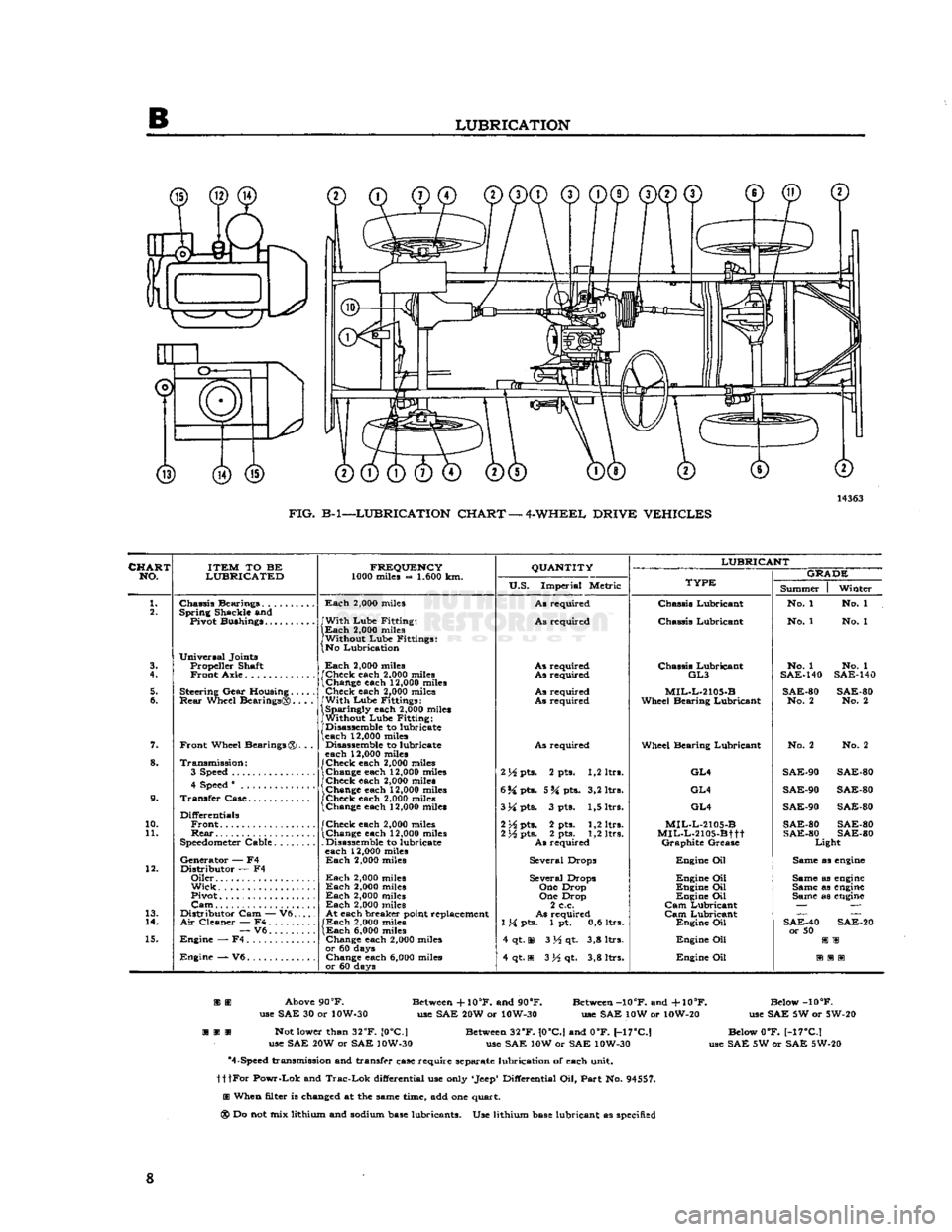
B
LUBRICATION D0®
® ® ®
FIG.
B-l—-LUBRICATION CHART
—
4-WHEEL DRIVE
VEHICLES
CHART NO.
ITEM
TO BE
LUBRICATED
10.
11.
13.
14.
Chassis
Bearings. . .
Spring
Shackle and Pivot Bushings...
Universal
Joints Propeller Shaft
Front
Axle
Steering
Gear
Housing
Rear
Wheel BearingstS
Front
Wheel Bearings
.
Transmission:
3
Speed
4 Speed °
Transfer
Case
Differentials
Front.
Rear
Speedometer Cable
Generator
— F4
Distributor
— F4
Oiler
Wick
Pivot.
Gam
Distributor
Cam — V6.
Air
Cleaner — F4
—
V6
Engine
— F4
Engine
— V6.
FREQUENCY
1000 miles — 1.600 km.
Each
2,000
miles
/With
Lube
Fitting;
(Each
2,000
miles [Without
Lube
Fittings:
\No Lubrication
Each
2,000
miles
f
Check
each
2,000
miles
\
Change each
12,000
miles
Check
each
2,000
miles
fWith
Lube
Fittings:
1
Sparingly each
2,000
miles
J
Without
Lube
Fitting:
|
Disassemble to lubricate
\each
12,000
miles
Disassemble to lubricate
each
12,000
miles
I
Check
each
2,000
miles
l
Change each
12,000
miles
/Check
each
2,000
miles
l
Change each
12,000
miles
!Check
each
2,000
miles
\
Change each
12,000
miles
f
Check
each
2,000
miles
\
Change each
12,000
miles
.
Disassemble to lubricate each
12,000
miles
Each
2,000
miles
Each
2,000
miles
Each
2,000
miles
Each
2,000
miles
Each
2,000
miles
At
each breaker point replacement
/Each
2,000
miles
\Each
6,000
miles
Change each
2,000
miles
or 60 days
Change each
6,000
miles
or 60 days
QUANTITY
U.S.
Imperial Metric
As
required
As
required
As
required
As
required
As
required
As
required
As
required
2H
Pts. 2 pts. 1,2 ltrs.
6 H pts. 5
M
pts. 3,2 ltrs.
3Mpti«
3 pts. 1,5 ltrs. 2
M
pts. 2 pts. 1,2 ltrs.
2
Yi
pts. 2 pts. 1,2 ltrs.
As
required
Several
Drops
Several
Drops
One
Drop
One
Drop
2 c.c.
As
required
1 H pts. 1 pt. 0,6 ltrs.
4 qt. m 314 qt. 3,8 ltrs.
4 qt.
11
3 34 qt. 3,8 ltrs.
LUBRICANT
TYPE
Chassis
Lubricant
Chassis
Lubricant
Chassis
Lubricant
GL3
MIL-L-2105-B
Wheel
Bearing
Lubricant
Wheel
Bearing
Lubricant
GL4
GL4 GL4
MIL-L-2105-B
MIL-L-2105-Bttt
Graphite
Grease
Engine
Oil
Engine
Oil
Engine
Oil
Engine
Oil
Cam
Lubricant
Cam
Lubricant
Engine
Oil
Engine
Oil
Engine
Oil
GRADE
No. 1 No.
1
No. 1 No. 1
No. 1
SAE-140
No. 1
SAE-140
SAE-80
No. 2
SAE-
No. 80
2
No. 2 No. 2
SAE-90
SAE
80
SAE-90
SAE
80
SAE-90
SAE
80
SAE-80
SAE-80
SAE
SAE
80
80
Light
Same as
engine
Same as
engine
Same as
engine
Same as
engine
SAE-40
or 50
SAE-20
Above 90
°F.
use SAE 30 or 10W-30
Not lower than
32°F.
[0°C.|
use SAE 20W or SAE 10W-30 Between
-f-10°F.
and 90
8F.
use SAE 20W or 10W-30 Between
-10°F.
and
+10°F.
use SAE 10W or 10W-20 Between
32eF.
[0°C.]
and 0°F.
l-17°Cl
use SAE 10W or SAE 10W-30
*4-Speed transmission and transfer case require separate lubrication of each unit.
tttFor
Powr-Lok
and
Trac-Lok
differential use only 'Jeep* Differential Oil,
Part
No. 94557.
SI
When filter is changed at the same time, add one quart.
®
Do not mix lithium and sodium base lubricants. Use lithium base lubricant as specified Below
-10°F.
use SAE 5W or 5W-20
Below 0°F. [-17°C.J
use SAE 5W or SAE 5W-20 8
Page 9 of 376
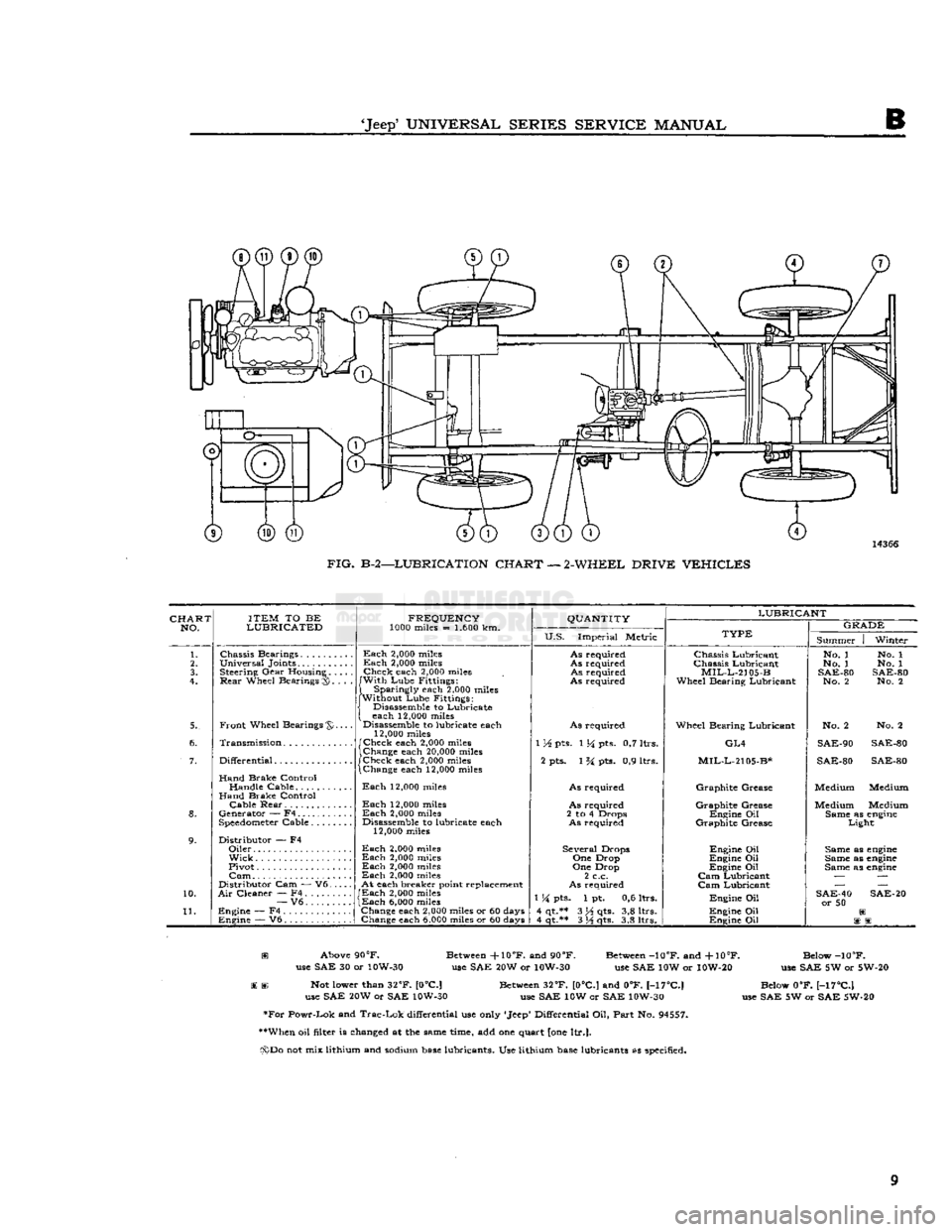
*Jeep?
UNIVERSAL
SERIES
SERVICE
MANUAL
FIG.
B-2—LUBRICATION
CHART
—
2-WHEEL
DRIVE
VEHICLES
CHART
NO
ITEM
TO BE
LUBRICATED
FREQUENCY
1000 miles = 1.600 km.
QUANTITY
U.S.
Imperial Metric
LUBRICANT
TYPE
Summer I Winter
Chassis
Bearings.....
Universal
Joints...... Steering
Gear
Housing
Rear
Wheel Bearings fx
Front
Wheel
Bearings®
Transmission
Differential
Hand
Brake Control Handle Cable
Hand
Brake Control
Cable
Rear
Generator — F4
Speedometer
Cable....
Distributor — F4
Oiler
Wick
Pivot
Cam
Distributor Cam — V6.
Air
Cleaner — F4
—
V6.
....
Engine
— F4
Engine
— V6
Each
2,000
miles
Each
2,000
miles
Check
each
2,000
miles
With
Lube Fittings;
Sparingly each
2.000
miles
Without Lube Fittings: Disassemble to Lubricate
each
12,000
miles
Disassemble to lubricate each
12,000
miles
Check
each
2,000
miles
Change each
20,000
miles
Check
each
2,000
miles Change each
12,000
miles
Each
12,000
miles
Each
12,000
miles
Each
2,000
miles Disassemble to lubricate each
12,000
miles
Each
2,000
miles
Each
2,000
miles
Each
2,000
miles
Each
2,000
miles
At
each breaker point replacement
Each
2,000
miles
Each
6,000
miles
Change each
2,000
miles or 60 days Change each
6.000
miles or 60 days
As
required
As
required
As
required
As
required
As
required
1 XA pts. 114 pts. 0,7 ltrs. 2 pts. 1 % pts. 0,9 ltrs.
As
required
As
required
2 to 4 Drops
As
required
Several
Drops One Drop
One Drop
2 c.c.
As
required
1
M
pts. 1 pt. 0,6 ltrs.
4 qt.** 3 H qts. 3,8 ltrs. 4 qt.** 3
}A
qts. 3,8 ltrs.
Chassis
Lubricant
Chassis
Lubricant
MIL-L-2105-B
Wheel Bearing Lubricant
Wheel Bearing Lubricant
GL4
MIL-L-2105-B*
Graphite
Grease
Graphite
Grease
Engine
Oil
Graphite
Grease
Engine
Oil
Engine
Oil
Engine
Oil
Cam
Lubricant
Cam
Lubricant
Engine
Oil
Engine
Oil
Engine
Oil No. 1 No. 1
No. 1 No. 1
SAE-80 SAE-80
No. 2 No. 2
No. 2 No. 2
SAE-90 SAE-80
SAE-80 SAE-80
Medium Medium
Medium Medium Same as
engine
Light
Same as
engine
Same as
engine
Same as
engine
SAE-40
or 50
®
Above
90°F.
Between -f
10°F.
and
90°F.
Between
-10°F.
and
-fl0°F.
Below
-10°F.
use SAE 30 or 10W-30 use SAE 20W or 10W-30 use SAE 10W or 10W-20 use SAE 5W or 5W-20
BE
St
Not lower than
32°F.
[08C] Between
32°F.
10°C] and 0°F.
l-17°CI
Below 0°F. [-17°C] use SAE 20W or SAE 10W-30 use SAE 10W or SAE 10W-30 use SAE 5W or SAE 5W-20
•For
Powr-Lok and
Trac-Lok
differential use only 'Jeep' Differential Oil, Part No.
94557.
**When oil filter is changed at the same time, add one quart {one
ltr.].
(x)Do not mix lithium and sodium
base
lubricants. Use lithium
base
lubricants as specified. 9
Page 10 of 376
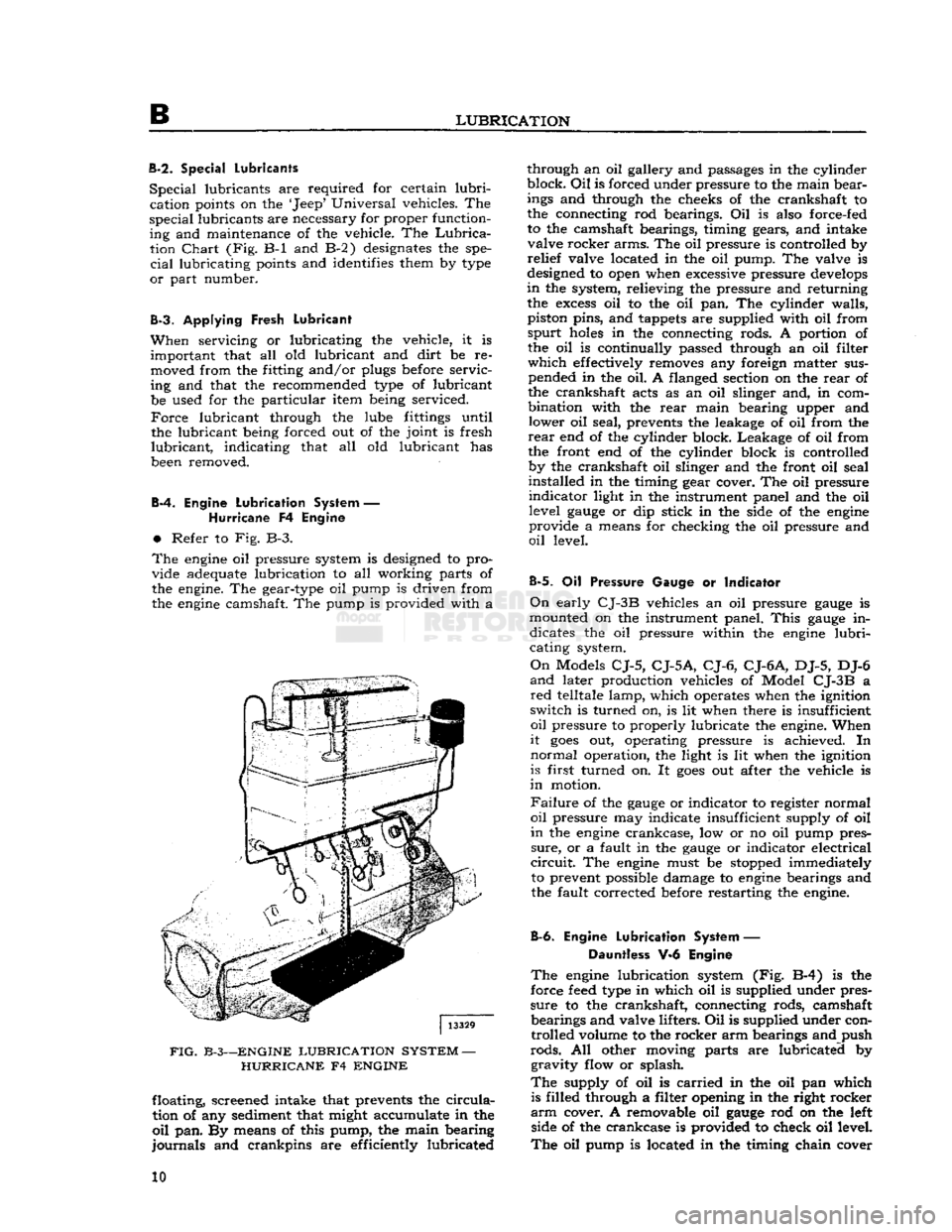
B
LUBRICATION
B-2.
Special Lubricants
Special
lubricants are required for certain
lubri
cation points on the 'Jeep' Universal vehicles. The
special
lubricants are necessary for proper function ing and maintenance of the vehicle. The
Lubrica
tion
Chart
(Fig. B-l and B-2)
designates
the spe
cial
lubricating points and identifies them by type
or
part number.
B-3.
Applying
Fresh
Lubricant
When
servicing or lubricating the vehicle, it is important that all old lubricant and
dirt
be re moved from the fitting and/or plugs before servic
ing and that the recommended type of lubricant be used for the particular item being serviced.
Force
lubricant through the lube fittings until the lubricant being forced out of the joint is fresh
lubricant,
indicating that all old lubricant has
been removed.
B-4.
Engine
Lubrication
System —
Hurricane
F4 Engine
•
Refer to Fig. B-3.
The
engine
oil pressure system is designed to pro
vide adequate lubrication to all working parts of
the engine. The gear-type oil pump is driven from
the
engine
camshaft. The pump is provided with a
FIG.
B-3—ENGINE
LUBRICATION
SYSTEM
—
HURRICANE
F4
ENGINE
floating, screened intake that prevents the
circula
tion of any sediment that might accumulate in the
oil
pan. By means of this pump, the main bearing
journals
and crankpins are efficiently lubricated through an oil gallery and passages in the cylinder
block.
Oil
is forced under pressure to the main bear
ings and through the cheeks of the crankshaft to
the connecting rod bearings. Oil is also force-fed
to the camshaft bearings, timing gears, and intake valve rocker arms. The oil pressure is controlled by
relief
valve located in the oil pump. The valve is
designed to open when excessive pressure
develops
in
the system, relieving the pressure and returning the
excess
oil to the oil pan. The cylinder walls,
piston pins, and tappets are supplied with oil from
spurt
holes
in the connecting rods. A portion of the oil is continually passed through an oil filter
which
effectively removes any foreign matter sus pended in the oil. A flanged section on the
rear
of
the crankshaft acts as an oil slinger and, in com
bination with the
rear
main bearing upper and lower oil seal, prevents the leakage of oil from the
rear
end of the cylinder block. Leakage of oil from
the front end of the cylinder block is controlled by the crankshaft oil slinger and the front oil seal
installed in the timing gear cover. The oil pressure
indicator
light in the instrument panel and the oil level
gauge
or dip stick in the side of the
engine
provide a means for checking the oil pressure and
oil
level.
B-5.
Oil Pressure Gauge or Indicator
On
early
CJ-3B
vehicles an oil pressure
gauge
is
mounted on the instrument panel.
This
gauge
in dicates the oil pressure within the
engine
lubri
cating system.
On
Models
CJ-5,
CJ-5A,
CJ-6,
CJ-6A,
DJ-5, DJ-6
and
later production vehicles of Model
CJ-3B
a
red
telltale lamp, which operates when the ignition
switch is turned on, is lit when there is insufficient
oil
pressure to properly lubricate the engine. When
it
goes
out, operating pressure is achieved. In
normal
operation, the light is lit when the ignition
is first turned on. It
goes
out after the vehicle is
in
motion.
Failure
of the
gauge
or indicator to register normal
oil
pressure may indicate insufficient supply of oil
in
the
engine
crankcase, low or no oil pump pres
sure,
or a fault in the
gauge
or indicator electrical
circuit.
The
engine
must be stopped immediately to prevent possible damage to
engine
bearings and
the fault corrected before restarting the engine.
B-6.
Engine
Lubrication
System — Dauntless V-6 Engine
The
engine
lubrication system (Fig. B-4) is the
force
feed
type in which oil is supplied under pres
sure
to the crankshaft, connecting rods, camshaft bearings and valve lifters. Oil is supplied under controlled volume to the rocker arm bearings and push
rods.
All other moving parts are lubricated by gravity flow or splash.
The
supply of oil is
carried
in the oil pan which is filled through a filter opening in the right rocker
arm
cover. A removable oil
gauge
rod on the left side of the crankcase is provided to check oil level.
The
oil pump is located in the timing chain cover 10
Page 12 of 376
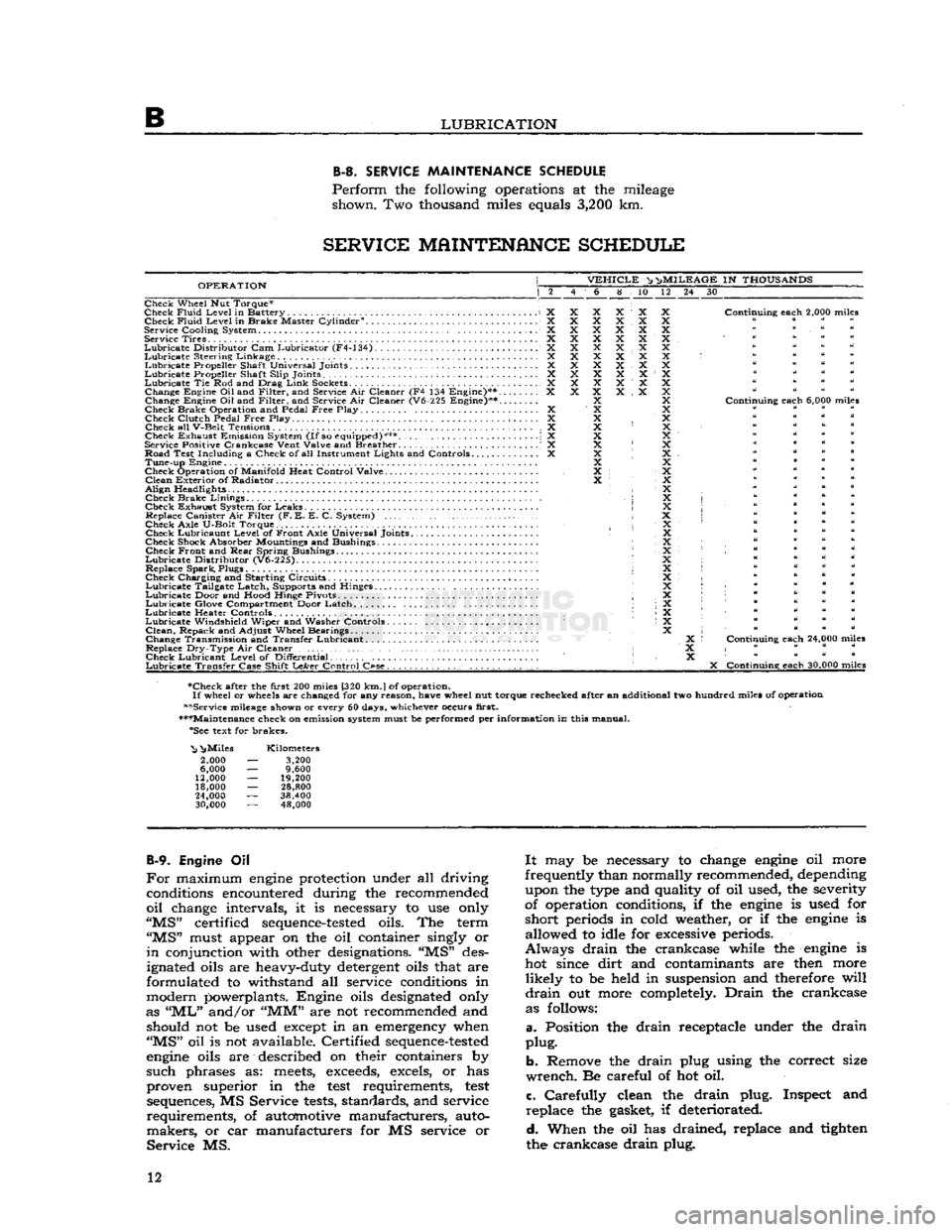
B
LUBRICATION B-3.
SERVICE
MAINTENANCE
SCHEDULE
Perform
the following operations at the mileage shown. Two thousand miles equals
3,200
km.
SERVICE
MAINTENANCE
SCHEDULE
OPERATION
VEHICLE
^ n>
MILEAGE
IN
THOUSANDS
6 8 10 12 24 30
Check Wheel Nut Torque*
Check
Fluid
Level
in Battery X Check
Fluid
Level
in Brake Master Cylinder0. X
Service
Cooling
System X Service Tires X
Lubricate
Distributor
Cam Lubricator (F4-134) X
Lubricate
Steering Linkage X
Lubricate
Propeller Shaft Universal Joints X
Lubricate
Propeller Shaft
Slip
Joints ; X
Lubricate
Tie Rod and Drag
Link
Sockets................................... X Change Engine
Oil
and
Filter,
and Service Air Cleaner (F4 134 Engine)** X
Change Engine Oil and
Filter,
and Service Air Cleaner (V6-225 Engine)**....
Check Brake Operation and Pedal
Free
Play X Check
Clutch
Pedal
Free
Play. .... X
Check all
V-Belt
Tensions X
Check Exhaust Emission System
(If
so equipped)*** \ X
Service Positive
Crankcase
Vent
Valve
and Breather . .' X
Road Test
Including
a Check of all Instrument
Lights
and Controls X Tune-up Engine
Check Operation of
Manifold
Heat
Control
Valve
Clean
Exterior of Radiator
Align
Headlights • Check Brake
Linings
,
Check Exhaust System for Leaks Replace Canister Air
Filter
(F. E. E. C. System)
Check
Axle
U-Bolt
Torque. Check Lubricaunt
Level
of Front
Axle
Universal Joints
Check Shock Absorber Mountings and Bushings Check Front and
Rear
Spring Bushings
Lubricate
Distributor
(V6-225).
Replace Spark, Plugs
Check Charging and Starting Circuits
Lubricate
Tailgate Latch, Supports and Hinges.
Lubricate
Door and
Hood
Hinge Pivots ;
Lubricate
Glove Compartment Door Latch
Lubricate
Heater Controls •
Lubricate
Windshield
Wiper and Washer Controls
Clean,
Repack and
Adjust
Wheel Bearings
Change Transmission and Transfer Lubricant. .
Replace
Dry-Type
Air Cleaner • Check Lubricant
Level
of
Differential
Lubricate
Transfer
Case
Shift
LeArer
Control
C«se.
. , . . . . . . . .
Continuing
each
2,000 miles
Continuing
each
6,000 miles
Continuing
each
24,000 miles
X
Continuing
each
30,000 miles
•Check after the
first
200 miles [320
km.
J
of operation.
If
wheel or wheels are changed for any
reason,
have
wheel nut torque rechecked after an additional two hundred miles of operation
••Service mileage shown or every 60 days, whichever occurs
first.
•••Maintenance check on emission system must be performed per
information
in this manual. "See text for brakes.
"Nj
^Miles
2,000
6,000
12,000
18,000
24,000
30,000
Kilometers
3,200
9,600
19,200
28,800
38,400 48,000
B-9.
Engine Oil
For
maximum
engine
protection under all driving conditions encountered during the recommended
oil
change intervals, it is necessary to use only
"MS"
certified
sequence-tested
oils. The term
"MS"
must appear on the oil container singly or
in
conjunction with other designations. "MS" des
ignated oils are heavy-duty detergent oils that are
formulated to withstand all service conditions in
modern powerplants. Engine oils designated only
as
"ML"
and/or
"MM"
are not recommended and should not be used except in an emergency when
"MS"
oil is not available. Certified
sequence-tested
engine
oils are described on their containers by
such
phrases as:
meets,
exceeds,
excels, or has
proven superior in the
test
requirements,
test
sequences, MS Service
tests,
standards, and service
requirements,
of automotive manufacturers, auto
makers,
or car manufacturers for MS service or
Service
MS.
It
may be necessary to change
engine
oil more
frequently than normally recommended, depending upon the type and quality of oil used, the severity
of operation conditions, if the
engine
is used for
short
periods in cold weather, or if the
engine
is allowed to idle for excessive periods.
Always
drain
the crankcase while the
engine
is hot since
dirt
and contaminants are then more
likely
to be held in suspension and therefore
will
drain
out more completely.
Drain
the crankcase as follows:
a.
Position the
drain
receptacle under the
drain
plug.
b.
Remove the
drain
plug using the correct size
wrench.
Be careful of hot oil.
c.
Carefully
clean the
drain
plug. Inspect and
replace
the gasket, if deteriorated.
d.
When the oil has drained, replace and tighten
the crankcase
drain
plug. 12
Page 13 of 376
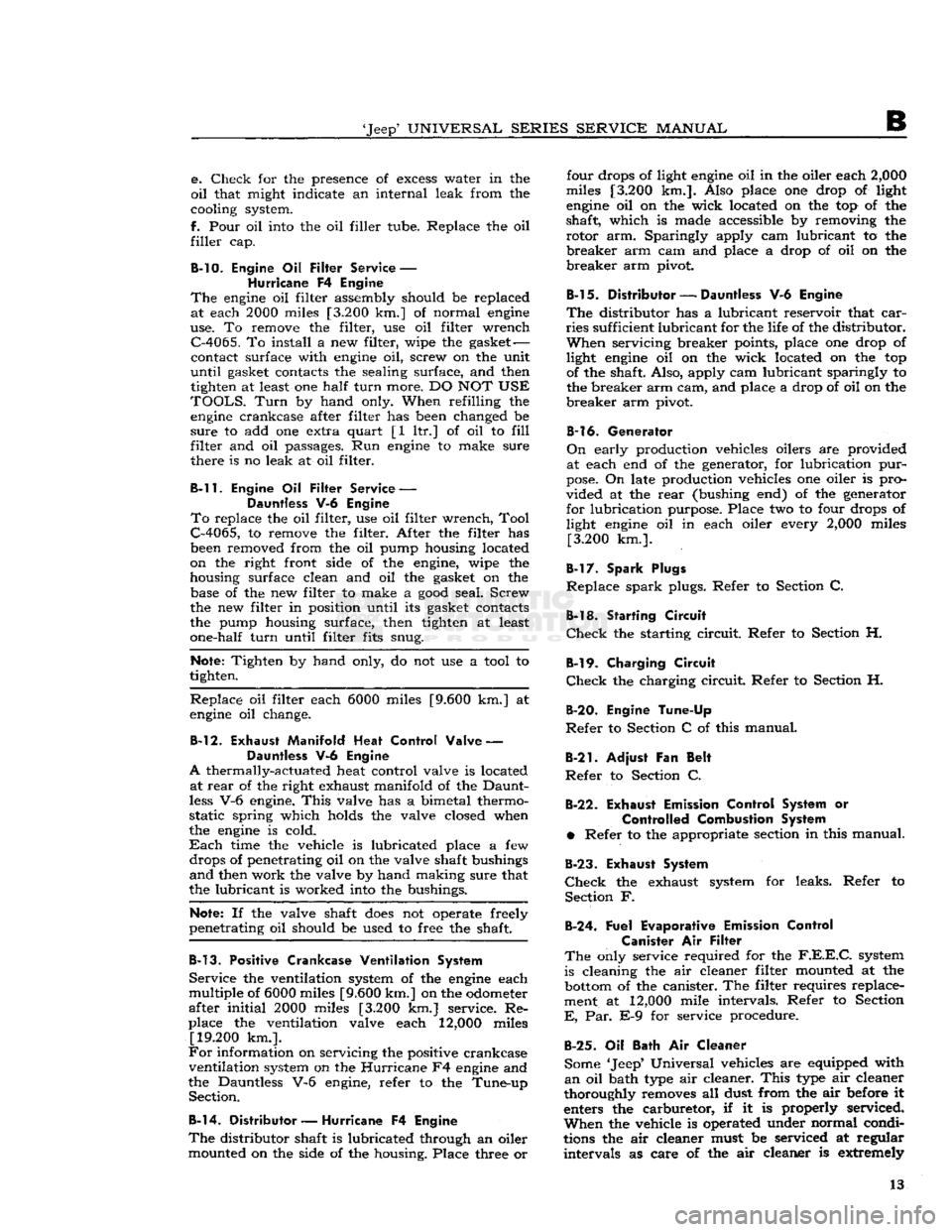
'Jeep'
UNIVERSAL
SERIES SERVICE
MANUAL
B
e.
Check
for the presence of
excess
water in the
oil
that might indicate an internal leak from the
cooling system.
f.
Pour oil into the oil filler tube. Replace the oil
filler
cap.
B-10.
Engine Oil
Filter
Service —
Hurricane
F4 Engine
The
engine
oil filter assembly should be replaced at each
2000
miles
[3.200
km.] of normal
engine
use. To remove the filter, use oil filter wrench
C-4065.
To install a new filter, wipe the gasket —
contact surface with
engine
oil, screw on the unit
until
gasket contacts the sealing surface, and then tighten at least one
half
turn
more. DO NOT USE
TOOLS.
Turn
by hand only. When refilling the
engine
crankcase after filter has been changed be
sure
to add one extra quart [1 ltr.] of oil to
fill
filter
and oil passages. Run
engine
to make sure there is no leak at oil filter.
B-l 1.
Engine Oil
Filter
Service — Dauntless V-6 Engine
To
replace the oil filter, use oil filter wrench, Tool
C-4065,
to remove the filter. After the filter has
been removed from the oil pump housing located
on the right front side of the engine, wipe the
housing surface clean and oil the gasket on the base of the new filter to make a
good
seal. Screw
the new filter in position until its gasket contacts
the pump housing surface, then tighten at least
one-half
turn
until filter fits snug.
Note:
Tighten by hand only, do not use a tool to
tighten.
Replace
oil filter each
6000
miles
[9.600
km.] at
engine
oil change.
B-12.
Exhaust
Manifold
Heat
Control
Valve
— Dauntless V-6 Engine
A
thermally-actuated heat control valve is located at
rear
of the right exhaust manifold of the Daunt
less
V-6 engine.
This
valve has a bimetal thermo
static spring which holds the valve closed when
the
engine
is cold.
Each
time the vehicle is lubricated place a few drops of penetrating oil on the valve shaft bushings
and
then work the valve by hand making sure that
the lubricant is worked into the bushings.
Note:
If the valve shaft
does
not operate freely
penetrating oil should be used to free the shaft.
B-l 3.
Positive
Crankcase
Ventilation
System
Service
the ventilation system of the
engine
each
multiple of
6000
miles
[9.600
km.] on the odometer
after
initial
2000
miles
[3.200
km.] service. Re
place the ventilation valve each
12,000
miles
[19.200
km.].
For
information on servicing the positive crankcase
ventilation system on the
Hurricane
F4
engine
and
the Dauntless V-6 engine, refer to the Tune-up Section.
B-l4.
Distributor
— Hurricane F4 Engine
The
distributor shaft is lubricated through an oiler mounted on the side of the housing. Place three or four drops of light
engine
oil in the oiler each
2,000
miles
[3.200
km.]. Also place one drop of light
engine
oil on the wick located on the top of the
shaft, which is made accessible by removing the
rotor
arm. Sparingly apply cam lubricant to the
breaker
arm cam and place a drop of oil on the
breaker
arm pivot.
B-l
5.
Distributor
— Dauntless V-6 Engine
The
distributor has a lubricant reservoir that
car
ries
sufficient
lubricant
for the life of the distributor.
When
servicing breaker points, place one drop of
light
engine
oil on the wick located on the top of the shaft Also, apply cam lubricant sparingly to
the breaker arm cam, and place a drop of oil on the
breaker
arm pivot.
B-l6.
Generator
On
early production vehicles oilers are provided
at each end of the generator, for lubrication
pur
pose.
On late production vehicles one oiler is pro
vided at the
rear
(bushing end) of the generator for lubrication purpose. Place two to four drops of
light
engine
oil in each oiler every
2,000
miles
[3.200
km.].
B-l
7. Spark Plugs
Replace
spark
plugs. Refer to Section C.
B-18.
Starting
Circuit
Check
the starting
circuit.
Refer to Section H.
B-l
9. Charging
Circuit
Check
the charging
circuit.
Refer to Section H.
B-20.
Engine Tune-Up
Refer
to Section C of this manual.
B-21.
Adjust
Fan
Belt
Refer
to Section C.
B-22.
Exhaust Emission
Control
System or
Controlled
Combustion System
•
Refer to the appropriate section in this manual.
B-23.
Exhaust System
Check
the exhaust system for leaks. Refer to Section F.
B-24.
Fuel Evaporative Emission
Control
Canister Air
Filter
The
only service required for the
F.E.E.C.
system
is cleaning the air cleaner filter mounted at the
bottom
of the canister. The filter requires replace
ment at
12,000
mile intervals. Refer to Section
E,
Par. E-9 for service procedure.
B-25.
Oil Bath Air Cleaner
Some 'Jeep' Universal vehicles are equipped with
an
oil bath type air cleaner.
This
type air cleaner
thoroughly removes all dust from the air before it enters the carburetor, if it is properly serviced.
When
the vehicle is operated under normal condi
tions the air cleaner must be serviced at regular
intervals
as care of the air cleaner is extremely 13
Page 14 of 376
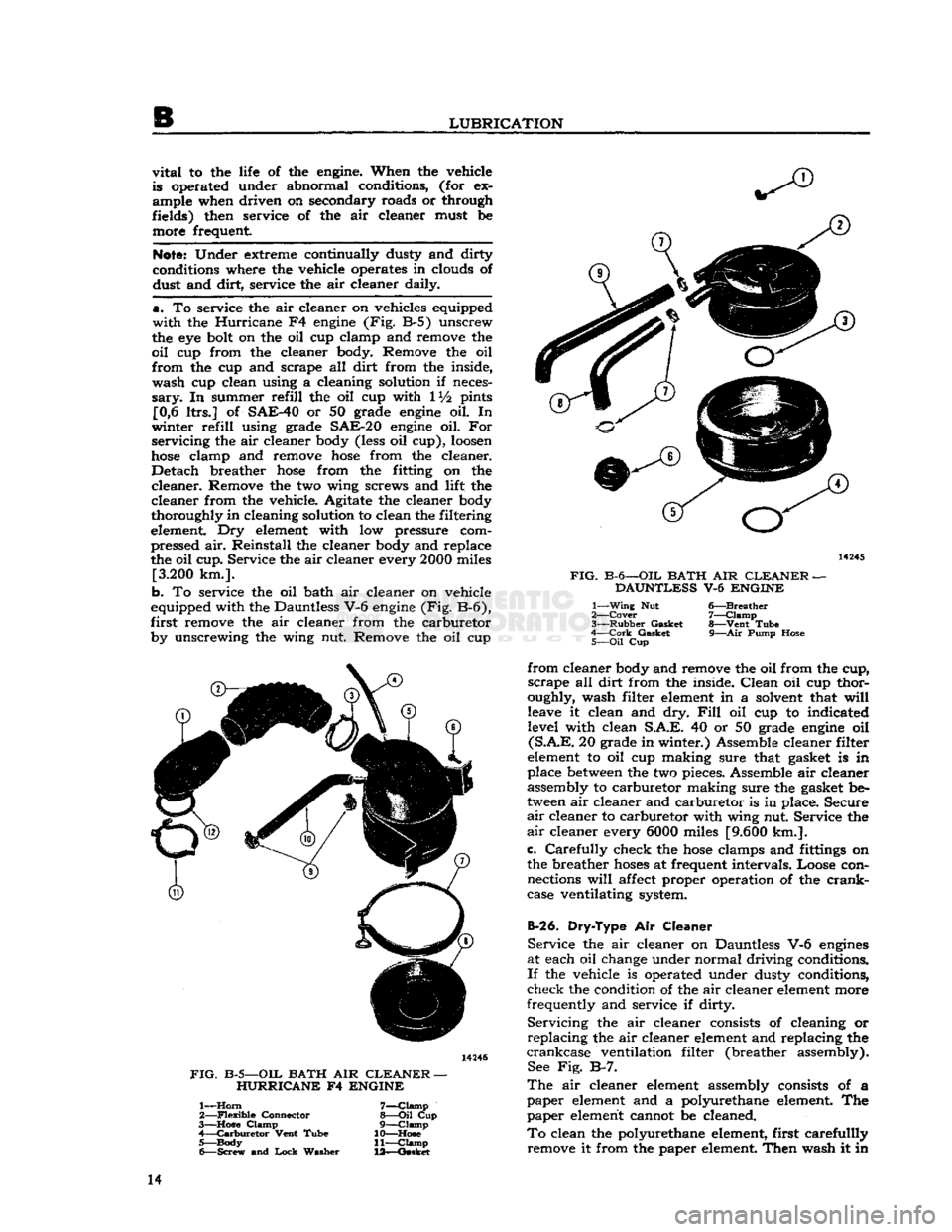
LUBRICATION
vital
to the life of the
engine.
When the vehicle
is operated under abnormal conditions, (for ex
ample when driven on secondary roads or through
fields) then service of the air cleaner must be more frequent
Note:
Under extreme continually dusty and dirty
conditions where the vehicle operates in clouds of dust and
dirt,
service the air cleaner daily.
a.
To service the air cleaner on vehicles equipped
with the
Hurricane
F4
engine
(Fig. B-5) unscrew
the eye
bolt
on the oil cup clamp and remove the
oil
cup from the cleaner body. Remove the oil from the cup and scrape all
dirt
from the inside, wash cup clean using a cleaning solution if neces
sary.
In summer
refill
the oil cup with IV2 pints [0,6 ltrs.] of
SAE-40
or 50 grade
engine
oil. In
winter
refill
using grade
SAE-20
engine
oil. For
servicing the air cleaner
body
(less
oil cup),
loosen
hose
clamp and remove
hose
from the cleaner. Detach breather
hose
from the fitting on the cleaner. Remove the two wing screws and lift the
cleaner from the vehicle. Agitate the cleaner
body
thoroughly in cleaning solution to clean the filtering
element.
Dry
element
with low pressure com pressed air. Reinstall the cleaner
body
and replace
the oil cup. Service the air cleaner every
2000
miles
[3.200
km.].
b. To service the oil bath air cleaner on vehicle
equipped with the Dauntless V-6
engine
(Fig. B-6),
first
remove the air cleaner from the carburetor
by unscrewing the wing nut. Remove the oil cup
FIG.
B-5—OIL
BATH AIR
CLEANER
-
HURRICANE F4 ENGINE 1—
Horn
7—Clamp
2—
Flexible
Connector
8—Oil
Cup
3—
Hon
Clamp
9—Clamp
A—Carburetor
Vent Tube 10—Hose 5— Body 11—Clamp
6—
Screw
and
Lock
Washer 13—Gasket
FIG.
B-6—OIL BATH AIR
CLEANER
-
DAUNTLESS V-6 ENGINE
1—WinB
Nut
2—
Cover
3—
Rubber
Gasket
4—
Cork
Gasket
5—
Oil
Cup 6—
Breather
7—
Clamp
8—
Vent
Tube 9—
Air
Pump Hose from cleaner
body
and remove the oil from the cup,
scrape all
dirt
from the inside.
Clean
oil cup thor
oughly, wash filter
element
in a solvent that
will
leave it clean and dry.
Fill
oil cup to indicated
level with clean
S.A.E.
40 or 50 grade
engine
oil
(S.A.E.
20 grade in winter.) Assemble cleaner filter
element
to oil cup making sure that gasket is in
place
between
the two pieces. Assemble air cleaner assembly to carburetor making sure the gasket
be
tween
air cleaner and carburetor is in place. Secure
air
cleaner to carburetor with wing nut. Service the
air
cleaner every
6000
miles
[9.600
km.],
c.
Carefully
check the
hose
clamps and
fittings
on
the breather
hoses
at frequent intervals. Loose connections
will
affect proper operation of the
crank
case ventilating system.
B-26. Dry-Type
Air Cleaner Service the air cleaner on Dauntless V-6
engines
at each oil change under normal driving conditions.
If
the vehicle is operated under dusty conditions,
check the condition of the air cleaner
element
more
frequently and service if dirty.
Servicing
the air cleaner consists of cleaning or replacing the air cleaner
element
and replacing the
crankcase
ventilation filter (breather assembly). See Fig. B-7.
The
air cleaner
element
assembly consists of a
paper
element
and a polyurethane
element
The
paper
element
cannot be cleaned.
To
clean the polyurethane
element,
first carefullly remove it from the paper
element
Then
wash it in 14
Page 15 of 376
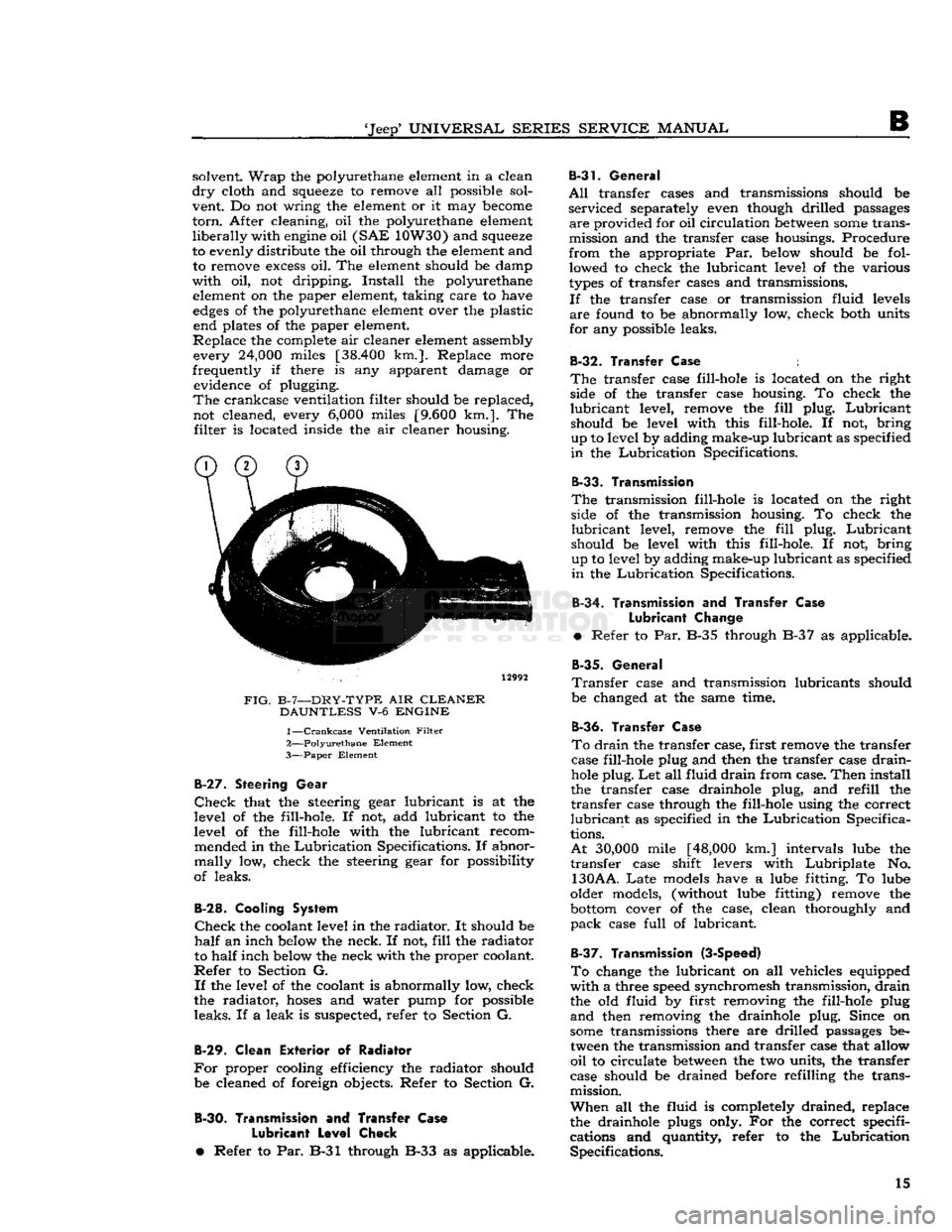
'Jeep*
UNIVERSAL SERIES SERVICE
MANUAL
B
solvent.
Wrap
the polyurethane element in a clean
dry
cloth and
squeeze
to remove all possible sol
vent. Do not wring the element or it may
become
torn.
After cleaning, oil the polyurethane element
liberally
with
engine
oil
(SAE
10W30) and
squeeze
to evenly distribute the oil through the element and to remove
excess
oil. The element should be damp
with
oil, not dripping.
Install
the polyurethane element on the paper element, taking care to have
edges
of the polyurethane element over the plastic end plates of the paper element.
Replace
the complete air cleaner element assembly every
24,000
miles
[38.400
km.]. Replace more
frequently if there is any apparent damage or evidence of plugging.
The
crankcase ventilation filter should be replaced, not cleaned, every
6,000
miles
[9.600
km.]. The
filter
is located inside the air cleaner housing.
12992
FIG.
B-7—DRY-TYPE
AIR
CLEANER DAUNTLESS
V-6
ENGINE
1—
Crankcase
Ventilation
Filter
2—
Polyurethane
Element
3—
Paper
Element
B-27.
Steering
Gear
Check
that the steering gear lubricant is at the
level of the fill-hole. If not, add lubricant to the
level of the fill-hole with the lubricant recom mended in the
Lubrication
Specifications. If abnor
mally
low, check the steering gear for possibility
of leaks.
B-28.
Cooling System
Check
the coolant level in the
radiator.
It should be
half
an inch below the neck. If not,
fill
the radiator
to
half
inch below the neck with the proper coolant.
Refer
to Section G.
If
the level of the coolant is abnormally low, check
the radiator,
hoses
and water pump for possible
leaks.
If a leak is suspected, refer to Section G.
B-29.
Clean
Exterior
of Radiator
For
proper cooling efficiency the radiator should be cleaned of foreign objects. Refer to Section G.
B-30.
Transmission
and
Transfer Case
Lubricant
Level
Cheek
•
Refer to Par. B-31 through B-33 as applicable.
B-31.
General
All
transfer cases and transmissions should be
serviced
separately even though drilled passages
are
provided for oil circulation
between
some
trans
mission and the transfer case housings. Procedure
from
the appropriate Par. below should be fol lowed to check the lubricant level of the various
types
of transfer cases and transmissions.
If
the transfer case or transmission fluid levels
are
found to be abnormally low, check both units
for any possible leaks.
B-32.
Transfer
Case
:
The
transfer case fill-hole is located on the right side of the transfer case housing. To check the
lubricant
level, remove the
fill
plug.
Lubricant
should be level with this fill-hole. If not, bring up to level by adding make-up lubricant as specified
in
the
Lubrication
Specifications.
B-33.
Transmission
The
transmission fill-hole is located on the right side of the transmission housing. To check the
lubricant
level, remove the
fill
plug.
Lubricant
should be level with this fill-hole. If not, bring
up to level by adding make-up
lubricant
as specified
in
the
Lubrication
Specifications.
B-34.
Transmission and Transfer
Case
Lubricant
Change
•
Refer to Par. B-35 through B-37 as applicable.
B-35.
General
Transfer
case and transmission lubricants should
be changed at the same time.
B-36.
Transfer
Case
To
drain
the transfer case, first remove the transfer
case fill-hole plug and then the transfer case
drain-
hole
plug. Let all fluid
drain
from case.
Then
install
the transfer case drainhole plug, and
refill
the
transfer
case through the fill-hole using the correct
lubricant
as specified in the
Lubrication
Specifica
tions.
At
30,000
mile
[48,000
km.] intervals lube the
transfer
case shift levers with
Lubriplate
No.
130AA.
Late
models have a lube fitting. To lube
older models, (without lube fitting) remove the
bottom
cover of the case, clean thoroughly and
pack
case
full
of lubricant.
B-37.
Transmission (3-Speed)
To
change the lubricant on all vehicles equipped
with
a three speed synchromesh transmission,
drain
the old fluid by first removing the fill-hole plug
and
then removing the drainhole plug. Since on
some
transmissions there are drilled passages be tween the transmission and transfer case that allow
oil
to circulate
between
the two units, the transfer
case should be drained before refilling the trans
mission.
When
all the fluid is completely drained, replace
the drainhole plugs only. For the correct specifi
cations and quantity, refer to the
Lubrication
Specifications. 15
Page 16 of 376
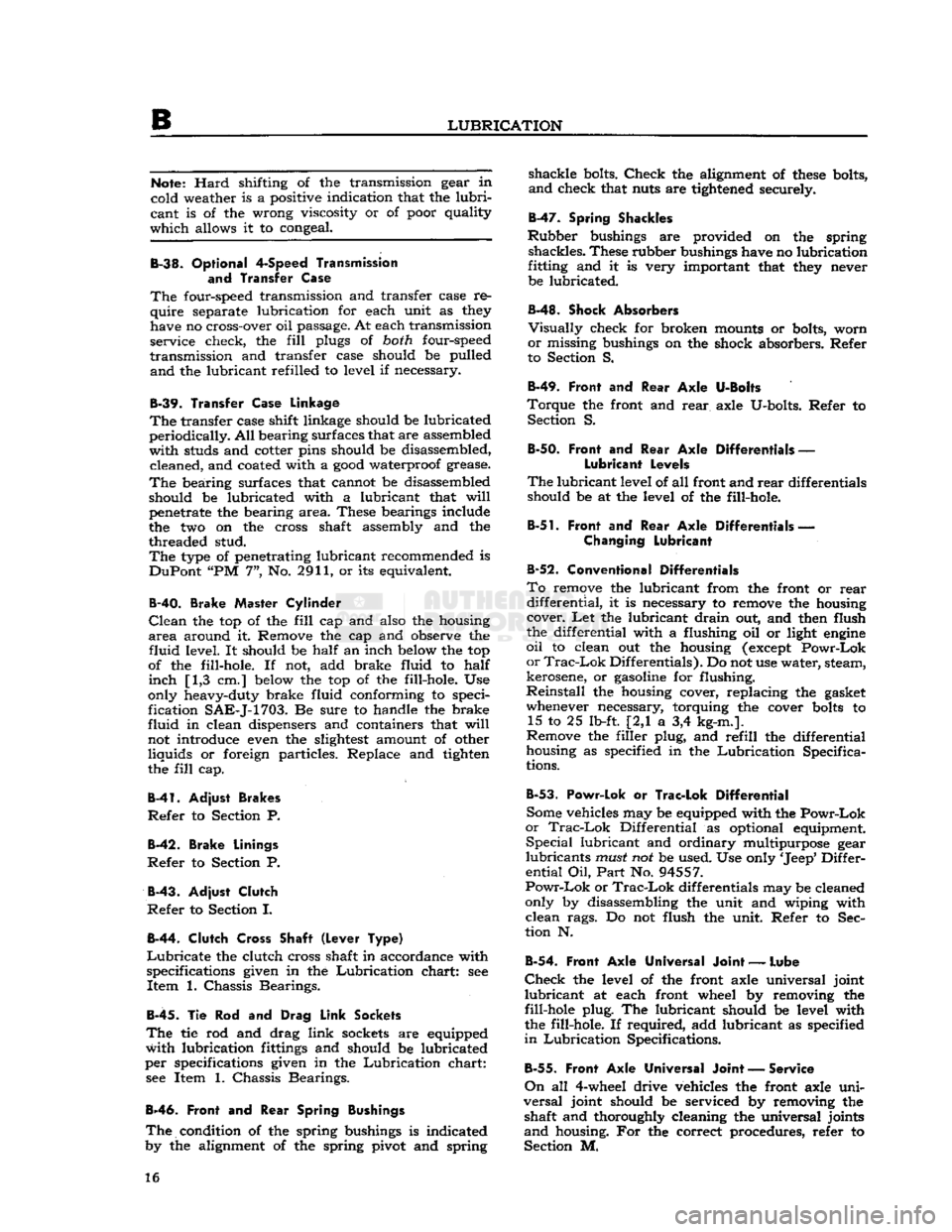
B
LUBRICATION
Note:
Hard
shifting of the transmission gear in
cold weather is a positive indication that the
lubri
cant
is of the wrong viscosity or of poor quality
which
allows it to congeal.
B-38.
Optional
4-Speed
Transmission
and
Transfer Case
The
four-speed transmission and transfer case re
quire
separate lubrication for each unit as
they
have no cross-over oil passage. At each transmission
service check, the
fill
plugs of
both
four-speed
transmission
and transfer case should be pulled
and
the lubricant refilled to level if necessary.
B-39.
Transfer
Case
Linkage
The
transfer case shift linkage should be lubricated
periodically.
All
bearing surfaces that are assembled
with
studs and cotter pins should be disassembled, cleaned, and coated with a
good
waterproof grease.
The
bearing surfaces that cannot be disassembled
should be lubricated with a lubricant that
will
penetrate the bearing
area.
These bearings include
the two on the cross shaft assembly and the
threaded stud.
The
type
of penetrating lubricant recommended is
DuPont
"PM 7", No. 2911, or its equivalent.
B-40.
Brake Master Cylinder
Clean
the top of the
fill
cap and also the housing
area
around it. Remove the cap and observe the
fluid
level. It should be
half
an inch
below
the top
of the fill-hole. If not, add brake fluid to
half
inch
[1,3 cm.]
below
the top of the fill-hole. Use
only heavy-duty brake fluid conforming to speci
fication
SAE-J-1703.
Be sure to handle the brake
fluid
in clean dispensers and containers that
will
not introduce even the
slightest
amount of other
liquids
or foreign particles. Replace and tighten
the
fill
cap.
B-41.
Adjust Brakes
Refer
to Section P.
B-42.
Brake Linings
Refer
to Section P.
B-43.
Adjust Clutch
Refer
to Section I.
B-44.
Clutch Cross Shaft (Lever Type)
Lubricate
the clutch cross shaft in accordance with
specifications given in the
Lubrication
chart: see
Item
1. Chassis Bearings.
B-45.
Tie Rod and Drag
Link
Sockets
The
tie rod and drag
link
sockets
are equipped
with
lubrication
fittings
and should be lubricated
per
specifications given in the
Lubrication
chart: see Item 1. Chassis Bearings.
B-46.
Front
and
Rear Spring
Bushings
The
condition of the spring bushings is indicated
by the alignment of the spring pivot and spring
shackle
bolts.
Check
the alignment of
these
bolts,
and
check that nuts are
tightened
securely.
B-47.
Spring
Shackles
Rubber
bushings are provided on the spring
shackles.
These rubber bushings have no lubrication
fitting and it is very important that
they
never be lubricated.
B-48.
Shock Absorbers
Visually
check for broken mounts or bolts, worn
or
missing bushings on the shock absorbers. Refer
to Section S.
B-49.
Front and
Rear
Axle
U-Bolts
Torque
the front and
rear
axle U-bolts. Refer to Section S.
B-50. Front
and
Rear
Axle
Differentials
—
Lubricant Levels
The
lubricant
level of all front and
rear
differentials should be at the level of the fill-hole.
B-51.
Front and
Rear
Axle
Differentials
—
Changing
Lubricant
B-52.
Conventional Differentials
To
remove the lubricant from the front or
rear
differential,
it is necessary to remove the housing cover. Let the lubricant
drain
out, and then flush
the differential with a flushing oil or light
engine
oil
to clean out the housing
(except
Powr-Lok
or
Trac-Lok
Differentials). Do not use water, steam,
kerosene, or
gasoline
for flushing.
Reinstall
the housing cover, replacing the gasket whenever necessary, torquing the cover
bolts
to 15 to 25 lb-ft. [2,1 a 3,4 kg-m.].
Remove the filler plug, and
refill
the differential
housing as specified in the
Lubrication
Specifica
tions.
B-53.
Powr-Lok
or
Trac-Lok Differential
Some vehicles may be equipped with the
Powr-Lok
or
Trac-Lok
Differential as optional equipment.
Special
lubricant and ordinary multipurpose gear
lubricants
must
not be used. Use only
'Jeep*
Differ
ential
Oil,
Part
No. 94557.
Powr-Lok
or
Trac-Lok
differentials may be cleaned
only by disassembling the unit and wiping with
clean
rags. Do not flush the unit. Refer to Sec
tion N.
B-54.
Front Axle Universal Joint
—
Lube
Check
the level of the front axle universal joint
lubricant
at each front wheel by removing the
fill-hole plug. The lubricant should be level with
the fill-hole. If required, add lubricant as specified
in
Lubrication
Specifications.
B-55.
Front
Axle
Universal
Joint
— Service
On
all 4-wheel drive vehicles the front axle
uni
versal
joint should be serviced by removing the shaft and thoroughly cleaning the universal joints
and
housing. For the correct procedures, refer to
Section M. 16
Page 17 of 376
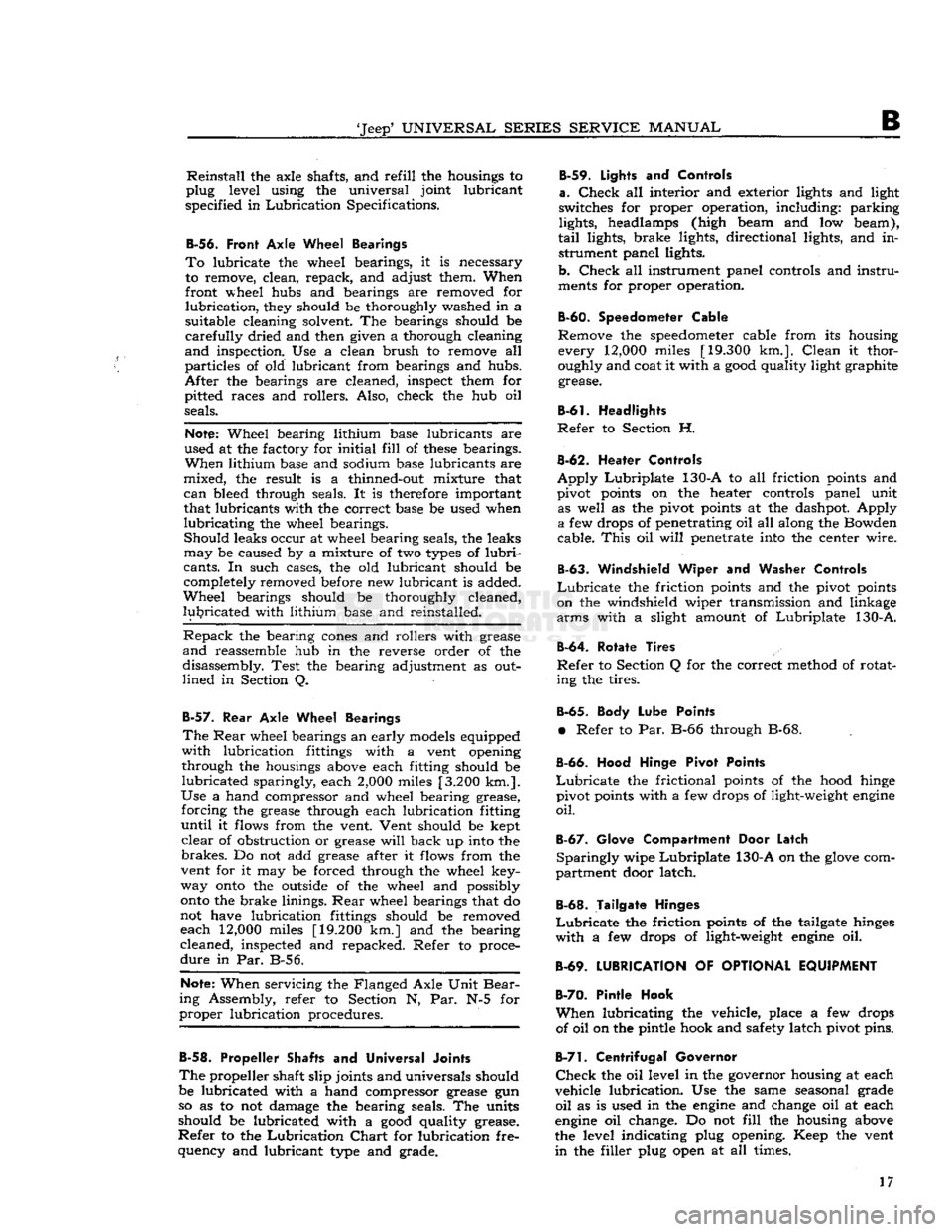
'Jeep'
UNIVERSAL SERIES SERVICE
MANUAL
B
Reinstall
the axle shafts, and
refill
the housings to
plug level using the universal joint lubricant
specified in
Lubrication
Specifications.
B-56.
Front
Axle Wheel Bearings
To
lubricate the wheel bearings, it is necessary
to remove, clean, repack, and adjust them. When
front wheel hubs and bearings are removed for
lubrication,
they should be thoroughly washed in a
suitable cleaning solvent. The bearings should be
carefully
dried and then given a thorough cleaning
and
inspection. Use a clean brush to remove all
particles
of old lubricant from bearings and hubs.
After
the bearings are cleaned, inspect them for
pitted races and rollers. Also, check the hub oil
seals.
Note:
Wheel bearing lithium base lubricants are
used at the factory for
initial
fill
of
these
bearings.
When
lithium base and sodium base lubricants are
mixed,
the result is a thinned-out mixture that
can
bleed through seals. It is therefore important
that lubricants with the correct base be used when
lubricating
the wheel bearings.
Should
leaks occur at wheel bearing seals, the leaks
may
be caused by a mixture of two
types
of
lubri
cants.
In such cases, the old lubricant should be
completely removed before new lubricant is added.
Wheel
bearings should be thoroughly cleaned,
lubricated
with lithium base and reinstalled.
Repack
the bearing
cones
and rollers with grease
and
reassemble hub in the reverse order of the
disassembly. Test the bearing adjustment as out
lined
in Section Q.
B-57.
Rear
Axle Wheel Bearings
The
Rear
wheel bearings an early models equipped
with
lubrication fittings with a vent opening
through the housings above each fitting should be
lubricated
sparingly, each
2,000
miles
[3.200
km.].
Use
a hand compressor and wheel bearing grease,
forcing
the grease through each lubrication fitting
until
it flows from the vent. Vent should be kept
clear
of obstruction or grease
will
back up into the
brakes.
Do not add grease after it flows from the
vent for it may be forced through the wheel key-
way
onto
the outside of the wheel and possibly
onto
the brake linings.
Rear
wheel bearings that do
not have lubrication fittings should be removed
each
12,000
miles
[19.200
km.] and the bearing
cleaned, inspected and repacked. Refer to proce
dure
in Par. B-56.
Note:
When servicing the Flanged Axle Unit
Bear
ing Assembly, refer to Section N, Par. N-5 for
proper
lubrication procedures.
B-58.
Propeller Shafts
and
Universal Joints
The
propeller shaft slip joints and universals should
be lubricated with a hand compressor grease gun so as to not damage the bearing seals. The units
should be lubricated with a
good
quality grease.
Refer
to the
Lubrication
Chart
for lubrication fre
quency and lubricant type and grade. B-59.
Lights
and
Controls
a.
Check
all interior and exterior lights and light
switches for proper operation, including: parking
lights, headlamps (high beam and low beam),
tail
lights, brake lights, directional lights, and in strument panel lights.
b.
Check
all instrument panel controls and
instru
ments for proper operation.
B-60.
Speedometer Cable
Remove the
speedometer
cable from its housing every
12,000
miles
[19.300
km.].
Clean
it thor
oughly and coat it with a
good
quality light graphite grease.
B-61.
Headlights
Refer
to Section H.
B-62.
Heater Controls
Apply
Lubriplate
130-A to all friction points and
pivot points on the heater controls panel unit as well as the pivot points at the dashpot. Apply
a
few drops of penetrating oil all along the Bowden
cable.
This
oil
will
penetrate into the center wire.
B-63.
Windshield Wiper and
Washer Controls
Lubricate
the friction points and the pivot points
on the windshield wiper transmission and linkage
arms
with a slight amount of
Lubriplate
130-A.
B-64.
Rotate Tires
Refer
to Section Q for the correct method of rotat ing the tires.
B-65.
Body Lube Points
•
Refer to Par. B-66 through B-68.
B-66.
Hood Hinge Pivot Points
Lubricate
the frictional points of the hood hinge
pivot points with a few drops of light-weight
engine
oil.
B-67.
Glove Compartment Door Latch
Sparingly
wipe
Lubriplate
130-A on the
glove
com
partment door latch.
B-68.
Tailgate Hinges
Lubricate
the friction points of the tailgate hinges
with
a few drops of light-weight
engine
oil.
B-69.
LUBRICATION
OF
OPTIONAL EQUIPMENT
B-70.
Pintle Hook
When
lubricating the vehicle, place a few drops of oil on the pintle hook and safety latch pivot pins.
B-7!.
Centrifugal Governor
Check
the oil level in the governor housing at each
vehicle lubrication. Use the same seasonal grade
oil
as is used in the
engine
and change oil at each
engine
oil change. Do not
fill
the housing above
the level indicating plug opening. Keep the vent
in
the filler plug open at all times. 17